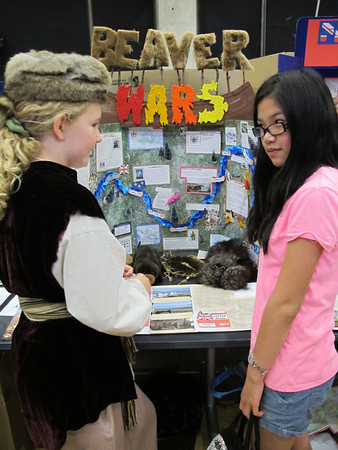Teaching Difficult Histories: Complexity is Compelling
7 January 2013 - 12:28pm
 Even before I was a teacher, my sense was that histories that aren’t presented as set in stone are always the most interesting. Histories that students can explore for themselves, where they can discover and investigate conflicting accounts, are the most compelling. Yet this sense isn’t always shared by others in public forums who have significant power to decide which histories are privileged, from teachers to policy makers.
Even before I was a teacher, my sense was that histories that aren’t presented as set in stone are always the most interesting. Histories that students can explore for themselves, where they can discover and investigate conflicting accounts, are the most compelling. Yet this sense isn’t always shared by others in public forums who have significant power to decide which histories are privileged, from teachers to policy makers.
Amy von Heyking’s contribution for Exploring Classroom Perspectives on the Past presents a story that I find compelling. She describes how in her Grade 5 class, she mentioned that her relatives had fought on the German side in World War II. Rather than acknowledging her student’s experience, and taking advantage of this valuable "teachable moment" to explore the complexities and human components of this historic event, her teacher simply dismissed her family's actions as a mistake. This story illustrates for me not only how powerful a teacher’s perspective is in the classroom, but also how difficult histories and privileged histories are intertwined.
James Moore, Canada’s Federal Heritage Minister, recently stated that Canadian history should be emphasized in all schools, because: “There’s a real need to know our national history better, so we can stay united and prosper as a country” (Moore, quoted in Mickleburgh, 2012). Praising Ontario, Quebec, Manitoba and Nova Scotia for having a Canadian History course as a high school graduation requirement, Moore is transparent in this desire for unity among Canadians. Interestingly, the Canadian History curriculum that Moore lauds is one that Paul Martin, as well as the Truth and Reconciliation Commission and Justice Murray Sinclair, have recently criticized for its lackluster treatment of First Nations history (Baluja, 2012).
Moore indicates that diversity is an important aspect of the Canadian story. However, tension exists between this desire to address diversity and the desire for a unifying national story. Now, I don’t mean to say that difficult histories are always a question of addressing diversity, but they do very often involve multiple and conflicting perspectives, which is what makes them difficult. Addressing diversity requires addressing multiple perspectives and sometimes conflict, yet this is problematic when there is one overarching story to be told. In order to maintain the coherence of that narrative, dissonance must be contained, which results in counter-stories being marginalized or silenced.
This desire for a unifying Canadian narrative seems to be behind the recent move to rename the Canadian Museum of Civilization the Canadian Museum of History, a move spearheaded by Heritage Minister Moore. Some of the permanent galleries will remain as they are, while two of the existing galleries will be revised to include Canadian milestones and defining figures and moments (CBC News, October 16th, 2012). I attended the November 23rd panel and roundtable discussion event in Fredericton hosted by the museum. These events, entitled My History Museum: A to Zed, have been held in major cities across the country, with the intention of having Canadians share their thoughts on what stories the new galleries should tell.
At the Fredericton event a participant asked why it wasn’t going to be called the Museum of Canadian History. He stated that he had the impression that the idea was to tell Canadian nation-building stories, which concerned him, and he was confused about the museum’s new name. The response from the hosts was that they wanted to be able to include international stories involved in Canada’s history. Even though the purpose behind the focus for the galleries is clear, those responsible for the changes seem not to want to appear too hard-line, using the language of diversity and acceptance while sending a different message. This is the case in schools as much as it is in public policy, as evidenced by Dr. von Heyking’s Grade 5 teacher.
If we are to effectively address difficult histories as history educators, adhering to the idea that there is one narrative that can tell all of our stories simply won’t work. As Kathy Bickmore (2006) argues, conflict in the curriculum is necessary. Teaching one story in an attempt to promote social cohesion strips students of the ability to learn how conflict and injustice have shaped our country, and also impedes students learning to recognize and take action against injustice by painting dissent and conflict as counter to the greater good and deserving of punishment. Complexity is compelling, and without addressing difficult histories head-on, history education is reduced to a set of dry facts, which has denied scores of students the thrill of historical inquiry. Counter to the popular social belief reflected in the curricula, research in this area has shown that the status quo-keeping approach is ineffective, while examining conflict and controversy actually fosters a higher level of student interest and engagement.
How do you acheive complexity in your classroom/museum lesson?
References:
Baluja, T. (2012, September 10). Paul Martin gives Canadian schools a failing grade in history. The Globe and Mail. Available online: http://m.theglobeandmail.com/
Bickmore, K. (2006). Democratic social cohesion (assimilation)? Representations of social conflict in Canadian public school curriculum. Canadian Journal of Education 29(2), 359-386.
Mickleburgh, R. (2012, October 20). Heritage Minister wants Canadian history taught in all high schools. The Globe and Mail. Available online: http://www.theglobeandmail.

Photo: participants in the June 2012 Ontario Heritage Fair, courtesy of the Ontario Heritage Fair

